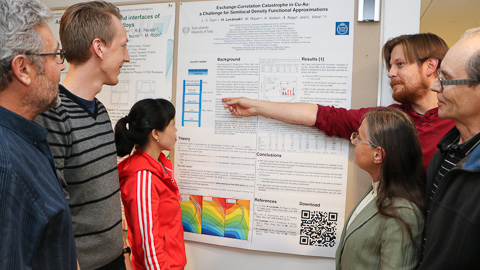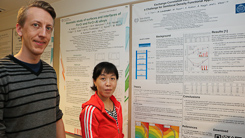Researcher Developed a New Approach for Density Functional Theory in Materials Science
What if we could create more powerful solar panels, find materials to replace rare metals in chemical industry, create lighter means of transport, or save nature? All this can be helped with the method Doctoral Candidate Henrik Levämäki has created for computational modelling of materials. The method makes the use of density functional theory more accurate than before.

Henrik Levämäki (second from the left) has had a supportive team by his side. The team includes Professor Levente Vitos from KTH Royal Institute of Technology (Sweden) and his Doctoral Candidate Li-Yun Tian, Professor Ágnes Nagy from the University of Debrecen (Hungary), Postdoctoral Researcher Matti Ropo from Tampere University of Technology, and Levämäki's supervisor, Professor Kalevi Kokko (on the right).
Professor Kalevi Kokko from the Department of Physics and Astronomy and his colleague Professor Levente Vitos from the KHT Royal Institute of Technology consider Levämäki's discovery to be a major development in the use of the density functional theory. The density functional theory (DFT) is a quantum mechanical modelling method used to investigate the electronic structure of microscopic systems. It was created by Pierre Hohenberg and Walter Kohn in 1964, when they proved that the ground state of a system is unambiguously determined by electron density.
– This was a major step forward for computational modelling, but there was a gap in the theory. One term had an unknown form, and scientists worldwide have been trying to solve the problem for the past 50 years. Some of the solution proposals are simple, enabling faster calculations, but the results are not always that accurate. Others are more accurate in their approximation, but their calculation is so heavy that they have been used quite sparingly, explains Kalevi Kokko.
Henrik Levämäki managed to create a new approximation for this challenging term. Levämäki's approximation is more accurate than the previous ones, and it is divided into smaller segments in such a way that calculation is also faster.
– From my point of view, this is one of the fundamental steps in DFT. This is an opening for something totally new, says Vitos.
Breaking Down the Problem
 degree and is now continuing it as a doctoral candidate. The aim is to remodel the above-mentioned difficult term in the density functional theory to a more accurate and practical form. Idea for the Physical Review Letters article started to shape up after Vitos' Doctoral Candidate Li-Yun Tian started to inspire Vitos with suggestions of a new approach.
degree and is now continuing it as a doctoral candidate. The aim is to remodel the above-mentioned difficult term in the density functional theory to a more accurate and practical form. Idea for the Physical Review Letters article started to shape up after Vitos' Doctoral Candidate Li-Yun Tian started to inspire Vitos with suggestions of a new approach.When Kalevi Kokko introduced Vitos and Levämäki, everything fell into place. In co-operation, an idea of a totally new approximation developed.
– Most of the approximations start from the fact that a mathematical formula can be derived from the laws of physics. An approximation derived this way is universal when calculating any type of system or molecule. However, practical calculations have proven that in certain cases, this approach is absolutely too inflexible and accurate results are impossible to calculate. We got an idea that what if we create a mathematical formula for each element, and this way we could break the problem down into smaller pieces, describes Levämäki.
Levämäki and his supportive team consisting of Kokko, Vitos, Tian, Hungarian Professor Ágnes Nagy from the University of Debrecen and Postdoctoral Researcher Matti Ropo from Tampere University of Technology managed to prove that Levämäki's method provides better results for alloys than any previous method.